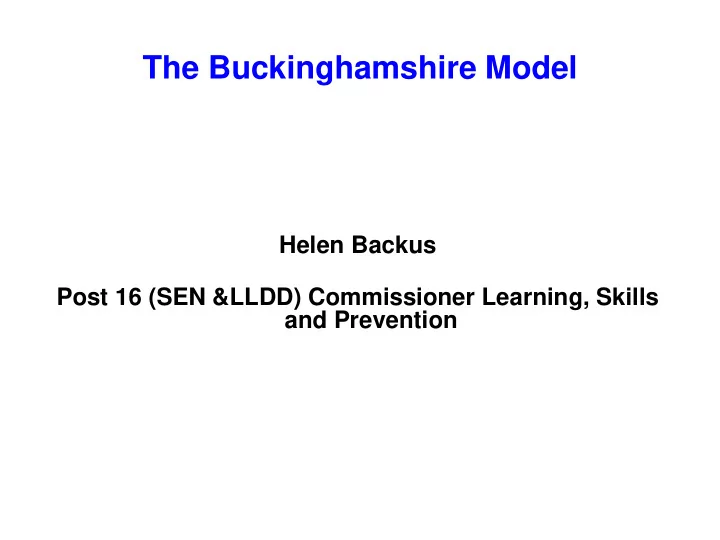

The Buckinghamshire Model Helen Backus Post 16 (SEN &LLDD) Commissioner Learning, Skills and Prevention
“New” Duties ?? • FE colleges will have a duty to admit students if the institution is named in an Education Health and Care plan. • FE colleges, along with others, will be under a duty to co-operate with the local authority to identify and meet the needs of young people with SEN
Timescales • The whole assessment and planning process, from the point an assessment is requested until the final EHC plan is issued, must take no more than 20 weeks • When LA’s request information as part of the assessment process, the information must respond within a maximum of 6 weeks from the request for assessment
5 Day A Week Provision ? • Don’t be intimidated! • We’re all in this together. • Working with other agencies not just LAs • Share your work with others especially cross boarder colleges and your support agencies
The Buckinghamshire Model Access to Open College Curriculum Independent Housing Living Training Home Unit Shared Lives working with Supported Living College, feeder Independent schools, housing Accommodation etc Residential Care Key Workers via ALS and/or Council Services linking directly in with home support workers Independent Living Training at home and in the community
The Buckinghamshire Model • 3 year learning programme – avoiding the cliff drop effect…. Based on learner need • Year 1 - 5 days a week, 35hrs • Year 2 – 4 days a week, 28hrs with other day through social care, health, DWP other • Year 3 – 3 days a week, 21hrs with other 2 days through social care, health, DWP other
GFE Modes of Programme Delivery 1. “ Virtual” learners – Enrolled at the college but the programme is delivered 100% in the community and at home/ residential placement. 2. Unit based learners – The programme is delivered entirely by partner agency in the unit and community only. 3. Unit based college learners – The programme is a mix of the colleges Pathway/ Foundation lessons (supported by the partner agency) and the unit/ community programme
GFE Modes of Programme Delivery 4. College led programme for those Pathways/ Foundation learners who require 5 day a week provision (Non college days via partner agency) 5. 100% college programme learner who is supported in the first term or so by partner agency to settle into college and can access the unit for “time out” and/ or therapy etc.
New curriculum and partner developments to date • 2 x New 6 th Forms into schools • SLD Course and new 5 day a week course • Small Animal Care • Rebound, music and hydro therapies • Computer Animation • SALT, OT and Physio into colleges • Long Term Housing
And ….. • More vocational focus via the Units and Colleges through provider and business partnerships • Supported Volunteering
Local FEC Development The Outcomes to Date • Quality Assurance in both Colleges = rolling improvement plans • 3 students have progressed from virtual model to accessing the unit and community. • 26 (90) students have achieved independent travel • 12 students have accessed work experience • 6 students have moved into local supported living accommodation • Positive feedback from families and students • Better engagement with Adult Learning
Destination, Objectives and Progression = Outcomes! • Does the young person have a ability to learn new things? Not regurgitate previous learning but learn new things. • What is the realistic destination? e.g. less support hours, living more independently, maintaining their own tenancy, volunteering or employment either supported or non supported • How will the learning programme help them get to their identified destination?
Destination • What is the realistic destination? e.g. less support hours, living more independently, maintaining their own tenancy, volunteering or employment either supported or non supported • How will the learning programme help them get to their identified destination?
Objectives and Progression • Look at the students destination e.g. Healthier Living. • The relative learning objectives will then be set e.g. recognising symptoms and when to call the doctor, how to call the doctors which can include sub objectives – using the telephone, making appointments etc
Outcomes! • When the student can with lower than the original or independently carry out the learning objective. • Student can now recognise health symptoms and when its appropriate to call the doctor, make an appointment, travel to and attend appointment • Outcome = Student can access health services thus outcome is being healthier!
Contact Details • Helen Backus Post 16 (SEN &LLDD) Commissioner Learning, Skills and Prevention Children and Young People's Services Buckinghamshire County Council • hbackus@buckscc.gov.uk
Recommend
More recommend